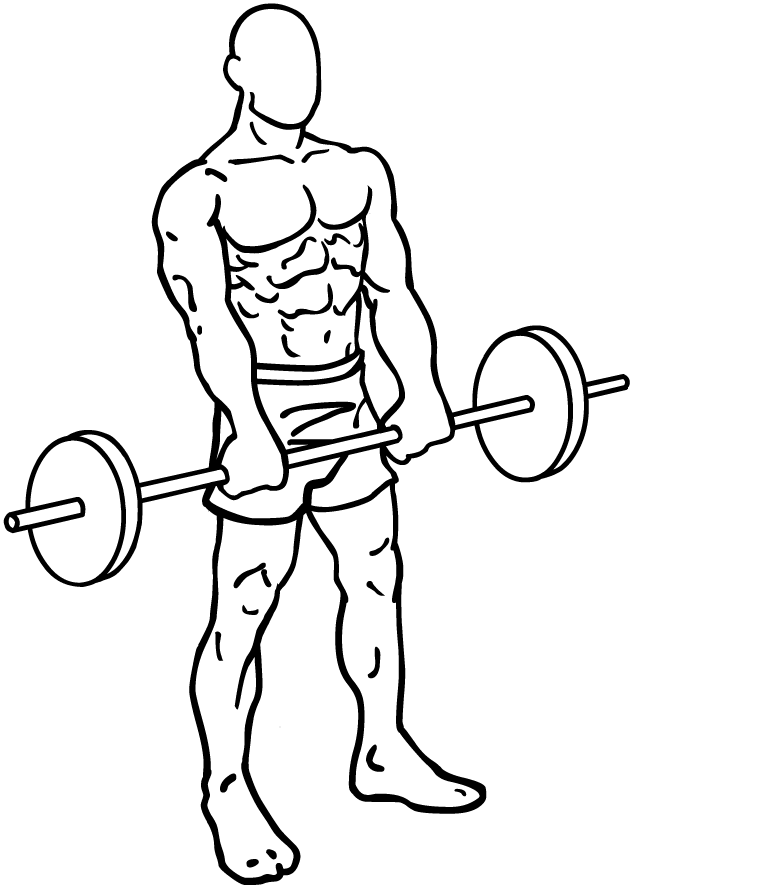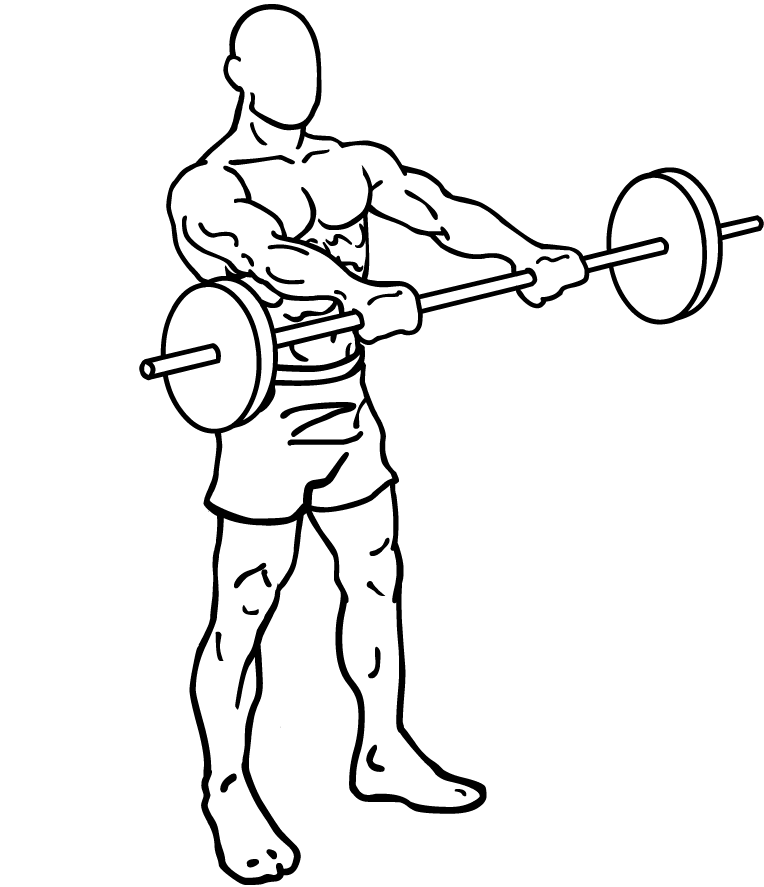Last Updated on September 30, 2014
Front barbell raises are a highly effective exercise that targets your shoulders, chest, and forearms. This movement is a staple for anyone looking to build upper body strength and enhance their physique. By focusing on your deltoids (shoulders), pectoral muscles (chest), and forearms, this exercise can provide a well-rounded approach to improving both strength and definition in these muscle groups. Whether you are an experienced lifter or a beginner in weightlifting, incorporating front barbell raises into your workout routine can yield impressive results.
In this detailed guide, we will break down everything you need to know about performing front barbell raises. From the proper technique to common mistakes and benefits, we will cover each aspect to help you master the movement.
Benefits of Front Barbell Raises
Before diving into the steps, it’s important to understand why front barbell raises should be part of your workout routine. Here are some key benefits:
- Shoulder Strength and Definition: The primary target of front barbell raises is the deltoids. By isolating these muscles, you can achieve greater shoulder definition, making your shoulders look broader and more defined.
- Chest and Forearm Engagement: While the deltoids take the brunt of the work, your chest and forearms also get a solid workout. This combination helps build a more balanced upper body.
- Improved Posture: Strengthening your shoulders and chest can help improve your posture, as these muscles play a critical role in keeping your upper body upright and stable.
- Increased Upper Body Stability: This exercise helps build stability in the upper body, which is essential for performing other strength exercises such as bench presses, deadlifts, and overhead presses.
- Functional Strength: Beyond aesthetics, this movement mimics natural motions that require shoulder strength, like lifting objects overhead or performing daily tasks that require pushing or pulling.
Now that you know why this exercise is beneficial, let’s dive into how to perform it with perfect form.
Step-by-Step Guide to Performing Front Barbell Raises
1. Start by Grasping the Barbell
To begin the exercise, select an appropriate weight for your fitness level. If you are new to front barbell raises, it is advisable to start light and gradually increase the weight as you become more comfortable with the movement.
Stand in front of a barbell that is positioned on the floor or a low rack. Approach the bar and grasp it with an overhand grip (palms facing down). Your hands should be positioned slightly wider than shoulder-width apart. This grip will allow you to evenly distribute the weight across your shoulders, chest, and forearms.
2. Set Your Feet and Engage Your Core
Once you have a firm grip on the barbell, stand up straight and position your feet shoulder-width apart. Make sure your knees are slightly bent—this will help protect your lower back and give you better balance throughout the movement.
Next, engage your core muscles. Drawing your abs in will provide stability and prevent you from arching your back, which is a common mistake. Keeping your core tight is essential for maintaining proper posture throughout the exercise.
3. Begin the Lift
With the barbell in your hands, slowly raise your arms in front of you. Your arms should remain straight but not locked at the elbows. Lift the barbell in a controlled, smooth motion until it reaches shoulder height. This part of the movement should be deliberate to ensure that you are activating the right muscles (deltoids, chest, and forearms).
Make sure to keep your wrists in a neutral position during the lift to avoid unnecessary strain on the joints.
4. Hold at Shoulder Level
Once the barbell reaches shoulder height, pause for a brief moment. This short hold allows your muscles to fully engage and adds an extra layer of intensity to the movement. You should feel your shoulders working hard to keep the barbell stable in this position.
Resist the temptation to lift the barbell higher than shoulder level, as this can shift the focus away from the shoulders and potentially cause injury.
5. Lower the Barbell with Control
After holding the barbell at shoulder level for a moment, it’s time to lower it back to the starting position. Slowly and deliberately lower the barbell back down in the same controlled manner in which you lifted it. Avoid letting gravity do the work for you—focus on maintaining muscle engagement throughout the descent.
Lowering the barbell too quickly can lead to a loss of form and increase the risk of injury, so take your time during this phase of the exercise.
6. Repeat for the Desired Number of Reps
Once the barbell is back at the starting position, you’ve completed one full repetition. For a solid workout, aim to complete 8 to 12 reps per set, depending on your fitness goals. You can do 3 to 4 sets of this exercise, ensuring you rest for about 30 to 60 seconds between sets.
Important Tips for Success
To get the most out of front barbell raises, follow these essential tips:
- Maintain Proper Posture: One of the most important aspects of this exercise is keeping your posture upright and stable. Do not lean back or arch your spine during the movement, as this can lead to lower back strain. Keep your core engaged and your chest lifted to maintain the correct posture throughout the entire range of motion.
- Focus on Controlled Movement: The key to an effective front barbell raise is control. The movement should be slow and deliberate, with a focus on engaging the target muscles. Avoid using momentum or swinging the barbell upward, as this reduces the effectiveness of the exercise and increases the risk of injury.
- Choose the Right Weight: Start with a lighter weight if you’re new to the exercise. As you build strength and confidence in your form, you can gradually increase the weight. Going too heavy too soon can compromise your form and lead to injury.
- Do Not Lock Your Elbows: Keep your arms straight but slightly bent at the elbows to avoid unnecessary strain on your joints. Locking your elbows during the movement can put undue stress on your joints and reduce the effectiveness of the exercise.
- Avoid Shoulder Pain: If you experience any shoulder pain during the exercise, stop immediately. This exercise can be tough on the shoulder joint, especially if you have pre-existing shoulder issues. Consult with a fitness professional or medical expert if shoulder pain persists.
Common Mistakes to Avoid
As with any exercise, there are common mistakes that can hinder your progress or increase the risk of injury. Here are some errors to watch out for:
- Leaning Back or Arching the Back: One of the most common mistakes is leaning back or arching the spine to compensate for the weight of the barbell. This places unnecessary strain on the lower back and can lead to injury. Focus on keeping your core engaged and maintaining an upright posture.
- Using Too Much Weight: Lifting a weight that is too heavy can compromise your form and increase the risk of injury. Start light, perfect your form, and gradually increase the weight over time.
- Swinging the Barbell: Using momentum to swing the barbell up to shoulder level takes the focus off the target muscles and reduces the effectiveness of the exercise. Keep the movement controlled and deliberate to fully engage the deltoids, chest, and forearms.
- Lifting the Barbell Too High: Lifting the barbell above shoulder level shifts the focus away from the shoulders and can place strain on other muscles, such as the traps or neck. Aim to raise the barbell only to shoulder height.
Variations and Progressions
Once you’ve mastered the basic front barbell raise, there are several variations you can try to add variety to your routine and further challenge your muscles:
- Single Arm Front Barbell Raise: Instead of using both arms, perform the exercise with one arm at a time. This variation requires greater stability and core engagement, making it a more challenging option for advanced lifters.
- Front Plate Raise: Instead of using a barbell, hold a weight plate with both hands and perform the exercise. This variation can help improve grip strength and provide a different stimulus for the shoulders and chest.
- Seated Front Barbell Raise: By performing the exercise in a seated position, you eliminate the ability to use momentum, forcing your shoulders to work even harder to lift the weight.
Front barbell raises are a fantastic exercise for anyone looking to build strength and definition in the shoulders, chest, and forearms. With proper form, controlled movement, and a focus on the target muscles, this exercise can help you achieve impressive upper body results. Remember to start with a manageable weight, maintain good posture, and avoid common mistakes to get the most out of your workout. As you progress, consider incorporating variations to keep your routine fresh and challenging. Whether you’re aiming for muscle growth or improved functional strength, front barbell raises are a valuable addition to your strength training program.








